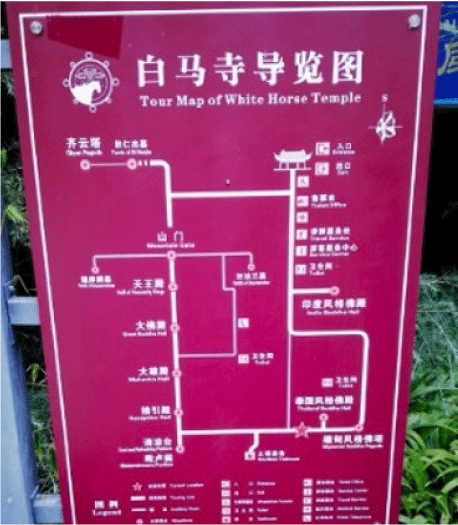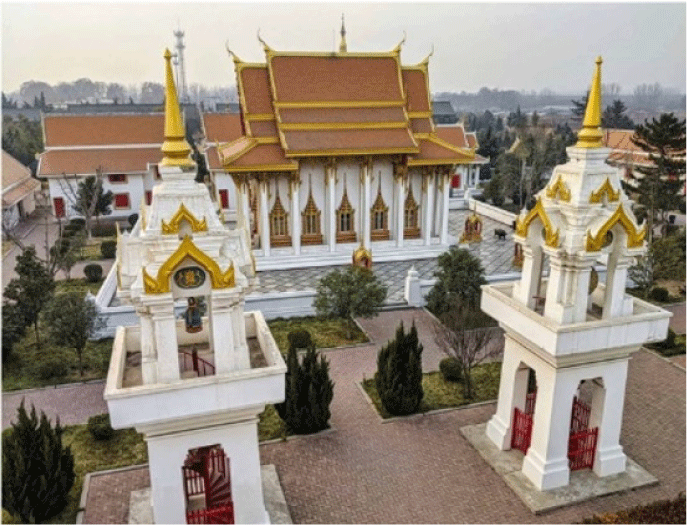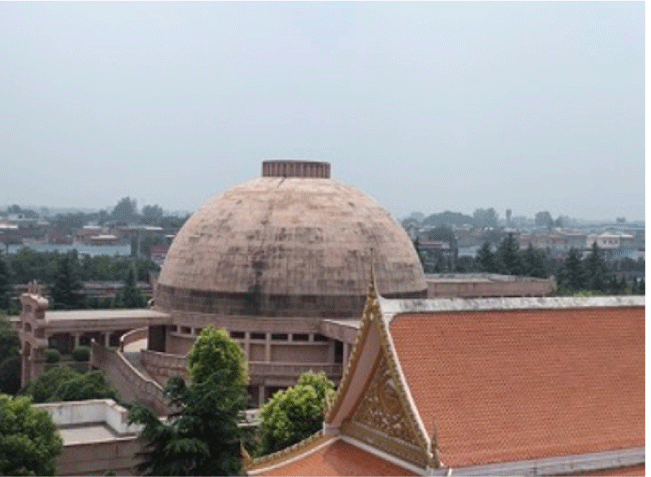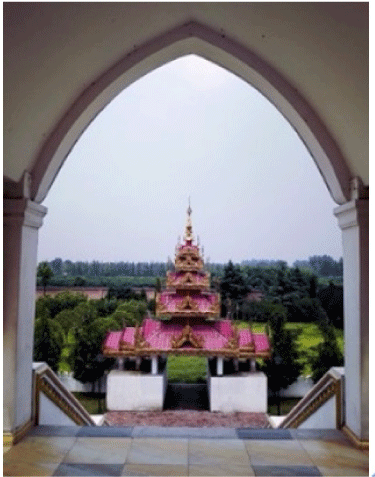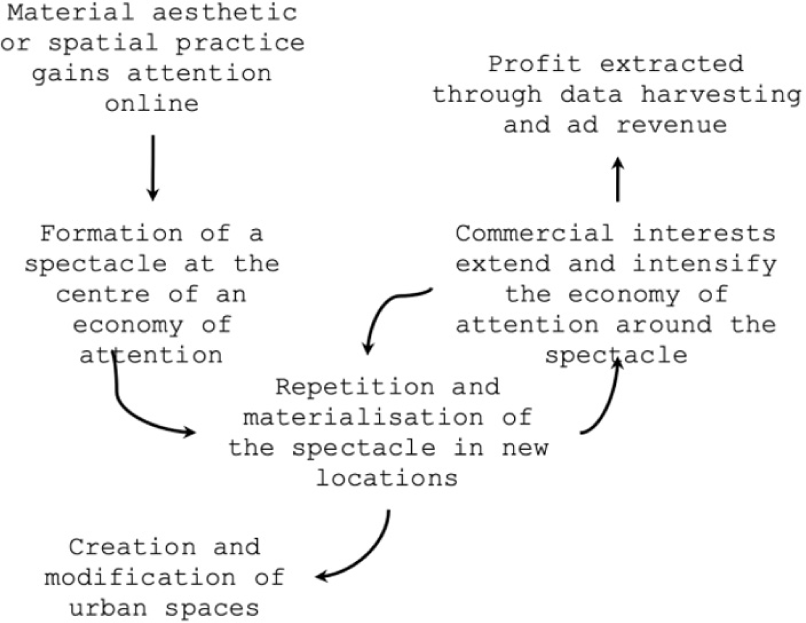Introduction
According to a broadly accepted Chinese tradition, White Horse Temple (白马寺, Bai ma si) was the first Buddhist temple in China. The establishment of the temple in Luoyang, Henan Province, has a pivotal place in the historical nerrative of Buddhism’s introduction to China (Chih, 2014 [1984]). The temple is traditionally recognized as China’s first Buddhist temple, with its origins dating back to the year 68 CE during the Eastern Han Dynasty, under the patronage of Emperor Ming (58–75 CE). The construction of the temple took place in the 11th year of the Yongping (永平) era.
Echoing this narrative, a decision to build the temple was percieved to have been an undertaking carried out in accordance with a dream the emperor had. The story says he dreamed of a sixteen-year-old boy, sixteen Chinese feet tall, with the aureole of the sun and moon radiating from his head and neck.1 This “golden god”, in fact, referred to the Buddha. According to tradition, the emperor dispatched envoys to the Western Regions in search of the god and, as a result, acquired Buddhist scriptures and images. At the time, because the scriptures were carried into China on the backs of white horses, White Horse was adopted as the name of the temple (Chih, 2014 [1984], 173).2
This prevailing narrative about the temple’s early astablishment and role in the spread of Buddhism described here above, may sound rather convincing; however, it is not at all accurate. Regardless though, in China and outside, this origin story still prevails as a lived tradition. It is widely circulated by local people as well as by scholars and diplomats (Sen 2012). At the same time, in the past century scholars have repeatedly problematized this narrative by pointing to significant misconceptions. The famous story about the dream of Emperor Ming of Han, the subsequent arrival of the first two Buddhist monks from India, and the building of the ’first’ Chinese Buddhist temple, is no more than a fable. It has been discredited by various scholars (Maspero 1901; Zürcher 2007 [1959], 22; Sen 2012). In fact, the story of Emperor Ming’s dream related to the Buddha dates from the fourth century and does not reflect the historical introduction of Buddhist ideas into China.
According to Tansen Sen, the reason that the story of Emperor Ming’s dream was adopted was because it linked the introduction of Buddhism with the Chinese court in an attempt to give legitimacy to the foreign doctrine (Sen 2012). The story was adopted, nevertheless, and many later Buddhist texts attest to its status as the first documented translation site for Buddhist texts in China. During this time, numerous Buddhists from the Western regions collaborated with local believers in translating a multitude of renowned Buddhist scriptures. This collaborative effort laid a sturdy foundation for the propagation of Buddhism across China (Guo, 2019). For these reasons, the temple was thereby referred to as “the source of Buddhism” (释源, shiyuan) and “the ancestral court”(祖庭, zuting). It signalled that Buddhism had an orthodox and legitimate place in China, and that the rulers agreed with and even advocated the widespread dissemination of Buddhism in China.
In this article, I wish to add to the discussion about the creation of a conception about Buddhism in China, by looking into the contemporary state of the temple. I argue that the modern re-configuration of the site is an attempt to emphasis particular narratives in regards to Buddhism in China through a control of material and digital spaces.
The Silk Road, Luoyang, and Buddhism
Besides its central role in history as the Chinese capital, Luoyang (洛阳) is also the eastern starting point of the ancient Silk Road (丝绸之路, Sichou zhi lu), and, as I have elaborated above, a locus for Buddhism in the Middle Ages. During the Eastern Han Dynasty, the domestic economic centre of the Silk Road shifted from Chang’an (长安) to Luoyang. In contemporary times, even though Luoyang is far from being an economic or cultural locus, it is perceived, as I will explore further, as having the ability to strengthen diplomatic interactions and exchanges with Buddhist groups across East Asia through Buddhist heritage and culture.
The temple also has a significant role in the tourism industry of Luoyang; it is considered one of Luoyang’s three ancient tourist sites (洛阳旅游 "老三篇", Luoyang luyou lao san pian). The recent renovations of the temple, which I discuss in the following sections, should also be viewed in the context of an effort to maximize the cultural heritage of Luoyang for the tourist economy. More generally, viewing the temple in the greater context of religious tourism in the modern PRC is essential.
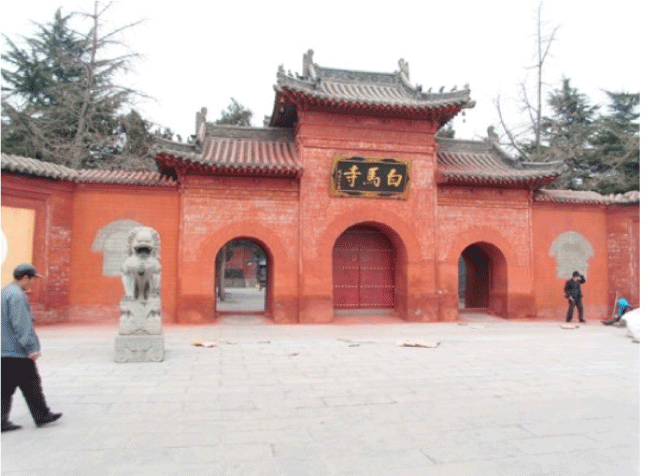
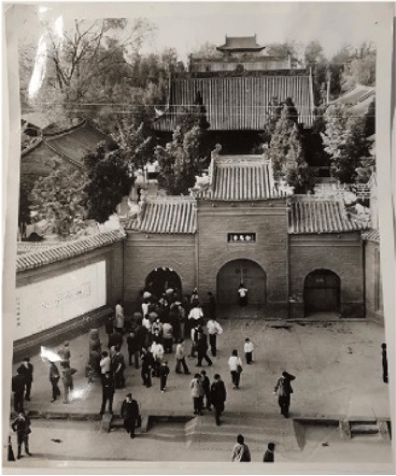
The Modern White Horse Temple
The existing ruins and historic sites that exist today in the temple complex are from the Yuan, Ming, and Qing Dynasties.3 The main temple buildings, large and complex, were reconstructed during the Ming and Qing dynasties, refurbished in the 1950s, and again in March 1973. However, the current temple complex, the one I visited in 2018, has been significantly expanded beyond these refurbishments. It contains numerous halls, divided by courtyards and landscaped gardens, covering an area of 200 acres. This was a gradual process of renovation that began in the early 1990s and 2000s and was completed in 2008. Uniquely, apart from the 32 acres of the old temple, which includes the great Buddha Hall and the Mahavira hall.
Later, an additional 170 acres were gradually added to the site. Uniquely, the rest of the site includes temples designed by and dedicated to other Buddhist countries besides China, such as Myanmar, Thailand, and Burma. As I will elaborate, the temples’ design, inspiration, and aesthetics are drawn from and dedicated to expressing the traditional Buddhist elements of these countries. Additionally, the Myanmar, Thailand, and India temples were donations that symbolize the cultural collaboration between these countries and the PRC in the early 2000s.
The first notable addition was the Thai temple – known as Wat Hame Assavaram in the Thai language – marking the first introduction of a temple based on Theravada doctrine in China. This temple stands as an overseas branch of the Maha Nikaya Sangha, operating under the esteemed oversight of Wat Saket Ratcha Woramahavihara in Thailand. The impetus for constructing this temple emerged through the initiative of His Holiness Somdej Phra Buddhacharya. Inaugurated in 1997, it boasts a Thai-style marble vihara that houses a replica of the revered Chinnarat Buddha statue. This statue, with dimensions of 109 inches in circumference, and 7.2 inches in height, and weighing 8 tons, was blessed by a gold-pouring ceremony at Wat Bowonniwet Vihara, in Bangkok (UTO). Notably, the restoration endeavours were made possible through the patronage of Wattana Asavahame, a prominent Thai politician.
Another striking addition to the landscape of White Horse Temple complex is the India Buddha Hall. A visual testament to enduring cultural connections, this hall boasts a captivating exterior shaped like a dome, adorned with intricate decorations and resplendent with statues. The inception of this temple stems from a proposal made by the Chinese in 2003, during visit by the then Indian Prime Minister, Atal Bihari Vajpayee, to Luoyang. Swiftly embracing the concept, Prime Minister Vajpayee recognized the profound potential of a Buddhist shrine as a conduit for fostering “people-to-people contact.” This endeavour coincided with the commemoration of sixty years of diplomatic ties, enhancing the cultural exchange between the two nations. To manifest this vision, the design took inspiration from the iconic Sanchi Stupa in Madhya Pradesh, India. Notably, the materialization of this architectural marvel involved the transportation of marble and granite in a staggering 200 shipping containers from India to China (Deccan Herald, 2010).
The last foreign temple to be built in the complex was the Burmese-style Buddha Hall (缅甸风格佛殿, Miandian fengge fodian), donated by the Republic of the Union of Myanmar, and built between 2012 and 2014, following a diplomatic visit by the Prime Minister of Myanmar to The White Horse Temple. Its main building, the Shwedagon Pagoda, is based on the Shwedagon Pagoda in Yangon, Myanmar. The four main gates and walls of the Pagoda were directly transplanted from the Mandalay Palace in Myanmar (njdaily.cn 2014).
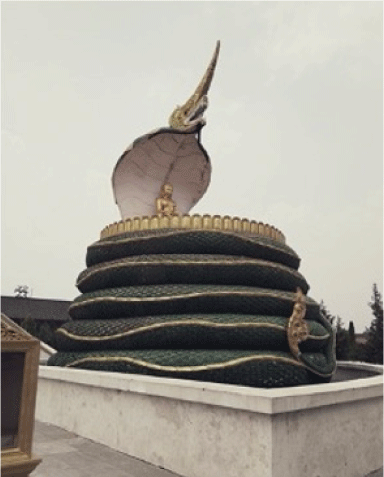
BRI and Buddhism
The context of these three foreign temples is seemingly straightforward. The combination of the old temple with the newer additions can be interpreted as symbolizing the impact of Luoyang as an important historical site for Buddhism, which China’s neighbours acknowledge and choose to cherish as a sign of good cultural relations. However, in light of the PRC’s political sphere of the past decade under Xi Jinping, the status, activities, and developments of White Horse Temple merit deeper inquiry.
In 2013 President Xi Jinping visited Central Asian and Southeast Asian countries and proposed the primary initiative of the “One Belt, One Road” (一带一路, Yidaiyilu; hereafter, BRI). In short, the BRI is a global infrastructure development strategy to invest in more than 150 countries and international organizations. It is central to the Chinese leader Xi Jinping’s foreign policy. The plan calls for China to assume a more significant leadership role in global affairs commensurate with its rising power and status, based on building a new or revitalized Silk Road (Belt and Road Portal 2023).
Under this grand plan, Buddhist temples, representatives, and practices have been harnessed to participate in the PRC’s agendas. This is, in fact, not at all surprising, since the Silk Road even bears another name, being recognized as the “Buddhist Road” (Dan and Qu 2022, 10). The Silk Road provided a network for the spread of the teachings of the Buddha, enabling Buddhism to become a world religion and to develop into a sophisticated and diverse system of beliefs and practices.
As mentioned previously, White Horse Temple is part of a network of tourist economy heritage sites. More particularly, its status has become even more central because of its potential role within the BRI. Since the early 2000s, the Chinese Communist Party has increasingly used various cultural heritage sites, including Buddhist sites, as soft power agents. Based on this context, this article will explore the impact of these developments on the temple. I have been led by questions such as, What happens to an important religious site once it has been used, redesigned, and renovated for the past three decades under the steady influence of diplomatic and political motives? How is the cultural heritage of the temple preserved? How do these developments affect the nature and manner in which people visit and spend time in the temple?
Tourism and Cultural Heritage
Beginning with the question of heritage preservation, some studies are worth mentioning. A study in the field of tourism, published in 2022 by Lin Dan and Xiuwei Qu, conducted a SWOT analysis (a model to assess the strengths, weaknesses, opportunities, and threats in a business model). Using this tool, they characterized the development of the temple as a weakness, referring to the lack of content in the recently constructed halls dedicated to Buddhism in foreign countries. The authors stated, “The international Buddhist temple exhibition area in the temple; Thai, Burmese Indian and other’s fail to fully reflect the culture and art of Buddhism in these countries” (Dan and Qu 2022, 10). I resonate with this reflection based on my visit to the halls and would add that the halls are literally empty of the array of statues, ornaments, and shrines one often finds in Buddhist spaces. The buildings resemble museum spaces rather than religious spaces.
Another study from 2019, by Guo Xiaotao was also published after the renovation and addition of the new foreign temples (Guo 2019). In the study, Guo stresses that the temple’s protection and the site’s development should focus on the relationship between Luoyang as a city and its relevance in the Han Dynasty. The author describes the additional buildings as demonstrating inclusiveness (包容性 , baorong xing) by looking at other Buddhist traditions.
However, this research also criticized the new development as failing to fully consider the fit with Luoyang’s surrounding historical and cultural sites. According to the publication, the White Horse Temple’s unique cultural and context are misunderstood. The study of White Horse Temple and the history of Chinese Buddhism cannot be separated from the study of the Han and Wei Dynasties. The author argues that the new monuments added are causing some degree of damage to the fundamental cultural and historical core of the temple, which is being “held hostage.” The rich spiritual and historical connections are being lost (Guo 2019).
As previously noted, the new renovation and addition of the foreign Buddha halls preceded the BRI and was officially designated to mark the symbolic importance of the ancient cultural relations between these countries and China. Yet, since the BRI was introduced, the state’s attention to the potential of the temple has grown. The foreign halls are not solely intended for Chinese Buddhists to learn about other Buddhist countries, but are also aimed at Chinese and foreign tourists. In 2017, Luoyang was designated as a pilot zone of the Henan Free Trade Zone (河南自贸区, Henan zimaoqu).
A plan for a China-Europe rail service was issued, emphasizing the strategic location of Luoyang on the Silk Road. Luoyang Airport was further expanded in 2021, adding routes from Japan, Thailand, and Vietnam for direct flights to the city. Furthermore, a comprehensive discussion on the future of Metro Line 1 aims to make it more accessible for international arrivals, with a direct metro line from the city centre to the temple (Guo 2019).
The profound significance of this temple for researchers delving into the realms of cultural heritage and tourism comes into full focus when placed within the sweeping vista of the broader tourism industry. Recent transformations echoing across South, Southeast, and East Asia have spearheaded a resounding resurgence: the dawn of Buddhist tourism. This cultural evolution entails a profound reimagining of the essence and importance of sites interwoven with the tapestry of Buddhism. Governments within these regions are embarking on a trajectory in which Buddhism’s embrace extends to encompass a tapestry woven with threads of nation-state ideologies, engendering an all-encompassing interpretation of this venerable tradition (Bruntz and Shedneck 2020, 1).
Remarkably, White Horse Temple asserts an active presence within the sacred nexus of the religious economy that pulsates through the vibrant tapestry of the tourism sector (Wang 2018, 43). This participation is emblematic of its role as a cultural nexus, interwoven with the socio-economic fabric that shapes and sustains the multifaceted domain of tourism. Within this synergy, the temple not only preserves its historical and spiritual heritage, but also traverses a dynamic trajectory in fostering meaningful interactions between culture, heritage, and the intrepid footfalls of curious travellers. As I have explored above, scholars are grappling with the question of how White Horse Temple can leverage its “ancestral court” advantage, preserving its traditional and Buddhist essence, while simultaneously embracing a market-oriented approach in the context of the current economic era.
Additionally, I would contend that beyond the realms of tourism and preservation, other agendas have also influenced this process. The White Horse Temple’s new additions convey an explicit message. Namely, a connecting cultural line between Myanmar, Thailand, and India, and the PRC. This symbolic gesture of cultural ties appears in the official plans for the BRI. Buddhism, in this context, is portrayed as a shared Asian tradition among the PRC’s potential allies and, therefore, a fruitful cultural common ground which can also strengthen economic and political collaboration.
Aside from this explicit message, I would suggest that there is also an implicit message that should also be considered. The focus on Luoyang as the historical locus of the spread of Buddhism in China also stresses the role and centrality of China in spreading Buddhism across East and South Asia. The construction of these Thai, Myanmar, and Indian temples surrounding the first Chinese Buddhist temple within the territory of the PRC suggests a claim on Buddhism as a cultural and religious tradition. This message is part of a broader endeavour for the sinicization of Buddhism (佛教中国化进程, fojiao zhongguo hua jincheng), which has been underway in the PRC in recent years, in which China has begun to describe Buddhism as an “Ancient Chinese Religion” (Ranade 2017). The modern reconstruction of the temple resonates with the notion of China as the locus of Buddhism, despite recognizing India as the original birthplace of Buddhism. This is, in fact, an underlining message, a part of the soft power strategy, which is a part of the BRI mechanism, as I will explore in the following section.
Soft Power and Buddhism
In politics, soft power is the ability to co-opt rather than coerce (in contrast to hard power). Using soft power entails shaping the preferences of others (the public or individuals) through appeal and attraction. The currency of soft power includes culture, political values, and foreign policies. In the Chinese context, soft power aims to make the country positive and attractive as a nation. While this is largely acknowledged in foreign relations, this process is also aimed inwardly, namely at Chinese citizens and how they perceive their own country (Lai and Lu 2013, 17).
However, how is this trajectory of cultural soft power relevant to the Buddhist religion? With its rich tapestry of traditions, beliefs, material expressions, and sects, Buddhism has had a profound and far-reaching impact on Chinese culture since its introduction. Over the past decade, Buddhism in China has undergone a process of harnessing, directing, and redefining within the cultural and political sphere of the country. The religion’s rich material and cultural history is increasingly being used for various political agendas. Scholars have also highlighted a noticeable increase in the use of soft power strategies directed at Buddhist actors and institutions to regulate and control the influence of the religion in China (Ashiwa and Wank 2020, 3–4).
While Xi Jinping’s treatment of religion incorporates harsh restrictions overall, its strategy regarding Buddhism is more complex than merely attacking it directly as a religion. The Chinese Communist Party (CCP) has not openly opposed the expansion of Buddhism, and has even initiated what it calls a “passive form of support”. However, state policies are intended to control the influence of Buddhism and use it for the state’s objectives (Laliberté 2011, 109; Shmushko 2022b).
Since Xi Jinping became leader of the People’s Republic of China (PRC) in 2012, the Chinese state has been globally promoting Chinese Buddhism. The aim is not to spread belief in Buddhism as a religion but rather to further the aspirations of the Communist Party of China (CPC) for China to be recognized as a country that has inherited a civilization in the modern world (Ashiwa and Wank 2020, 3–4).
Buddhism can also be perceived as an element of “soft power” used by the state in internal affairs, and as a cultural resource used in external politics. The CCP’s current approach is to use religion for its means and agenda, and to give Buddhism a more strategic role in society. People’s responses to the attitude, regulations, and demands of the BAC (中国佛教協会, Zhongguo fo jiao xiehui, Buddhist Association of China,), which the CCP monopolizes, is not necessarily rejection or disgruntled obedience (Ashiwa and Wank 2009).
In 2015, the BAC Ninth National Congress formally recognized the global promotion of Chinese Buddhism as a critical activity. It called for Chinese Buddhism to “go out” (走出去, zou chuqü) of China to other countries in order to “tell the Chinese story well” to their people so they could realize China’s accomplishments and peaceful intentions. These efforts were referred to as “soft power” (软实力, ruan shili), “public diplomacy” (公共外交, gonggong waijiao), and “person-to-person diplomacy” (人间外交, renjian waijiao), and were linked to the BRI (Ashiwa and Wank 2020, 3–4).
These endeavours are not exclusive to China. For India, Buddhism is a useful enhancer of cultural soft power. The religion has, over the past decade, increased in importance for India as New Delhi tries to re-energize the religious tradition and integrate it into the country’s cultural strength (Ranade 2023). India, which has been home to Buddhism since its birth, sees Buddhism as a way of strengthening its relationship with Southeast Asian nations, and as a means of preserving the religious and cultural practices of the Tibetan Buddhist people who have sought refuge in India.
Buddhism as Culture
One example of the state’s use of religion is Xi Jinping’s ongoing emphasis on framing Buddhism as a part of the cultural heritage of the Chinese people. The CCP now considers Buddhism to be part of Chinese civilization’s core (Xi 2014). The party’s current line is to flatten Buddhism into cultural activities and expressions in Chinese society, often disconnecting it from its religious and spiritual aspects (Shmushko 2022a). In recent years, several arguments have been made by Xi Jinping regarding Buddhism being a tradition (文化, wenhua), not a religion (Dubois 2015, 56). In his speeches, he expresses a will to blend religion into culture:
[…] we must continue to walk the path of socialism with Chinese
characteristics; actively practice the core values of socialism, promote Chinese culture, strive to fuse the religious teachings and Chinese culture (Xi 2016).
We also see that the BAC is promoting discursive forms of Buddhism. One of them is “Buddhist culture.” This refers to Chinese Buddhist-inspired values and practices that people can pursue as lifestyles and hobbies without questioning beliefs or understanding Buddhist teachings (Ashiwa and Wank 2020, 6). The way that Buddhism is approached in this manner reflects a broader discourse prevalent in contemporary globalized societies. Religion is often utilized as a cultural resource, or what Pierre Bourdieu referred to as “symbolic capital” (Bourdieu 1986, 26). Nevertheless, the utilization of such resources differs across nation-states and social groups (Geoffroy 2004, 35). In China, culture has not only become an integral part of the entrepreneurial vision of the state, but consumer citizenship and leisure culture are also officially promoted. This highlights the evolving relationship between religion, cultural dynamics, and the state’s efforts to encourage certain forms of cultural expression and consumption within the society.
The White Horse Temple Goes Online
Relevant to this paradigm of Buddhism as a cultural phenomenon, it is useful to inquire to how Chinese visitors respond to the temple’s renovation. In recent years, Chinese temple visits are highly documented on social media, which incapsulates various aspects of Chinese Buddhism, including temples creating online sanghas, conducting online rituals, and documenting pilgrimages and worship (Zhang 2017; Shmushko 2023). Concerning one aspect of these responses, I began researching social media representations of users sharing their visits to The White Horse Temple.
As part of my research on social media and religious participation, I studied Buddhist online activity on an app called the Little Red Book (小红书, xiao hong shu), which has been described as the Chinese answer to Instagram, an app highly centred on visual content.4 Entering “Baima si” into the search line of the social media app, I was not surprised to see hundreds of results tagging the temple in its renovated form. Yet what caught my eye were dozens of users who had uploaded photos with content and aesthetics as presented in the screenshots in Figures 9–14. These posts, which were uploaded to the Little Red Book in the past five years, portray Chinese women dressed in traditional ethnic and cultural garments related to the aforementioned countries. One image presents a woman dressed in Miao clothing and posing in the Thai Buddha Hall (see Figure 10). Another example shows a Chinese woman dressed in an Indian sari, also photographed in the area of the foreign temples.
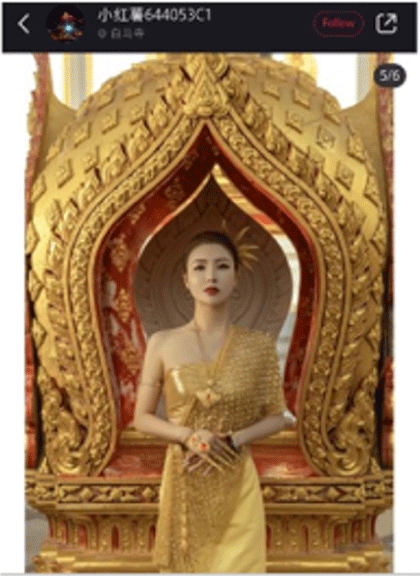
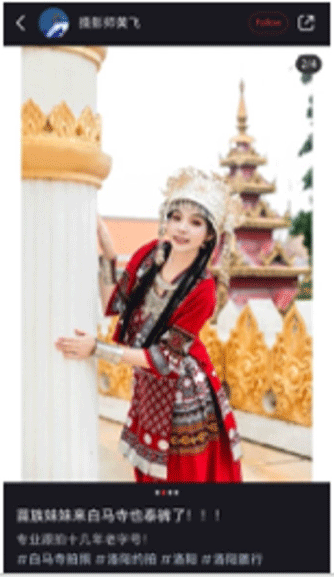
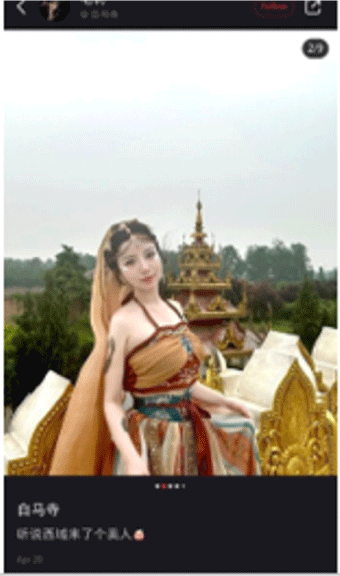
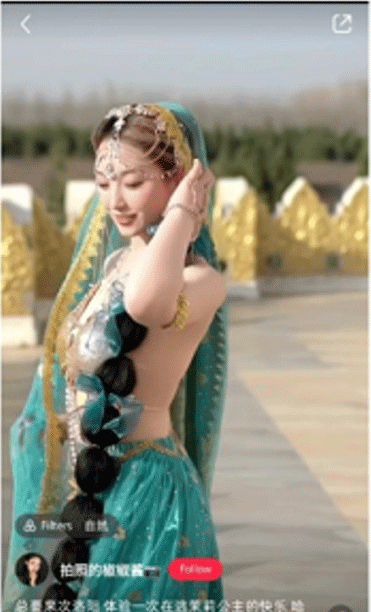
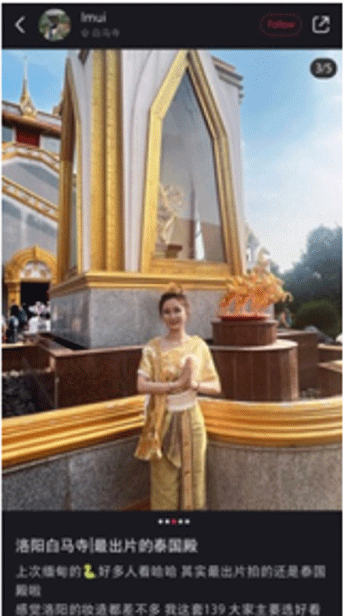
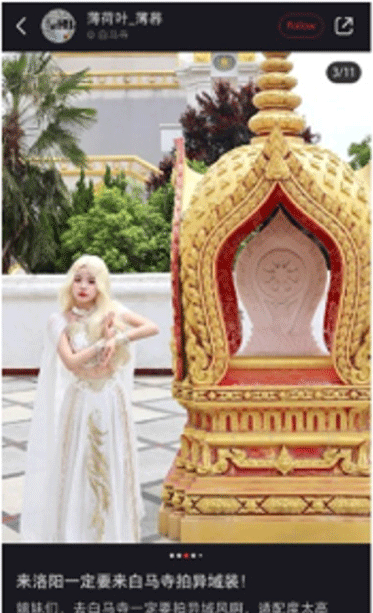
The other examples are less specific yet present the siilar visual representation of fashionable poses and clothing. The examples presented here are only a few of several hundrends of such posts, which pop up when one searches for the temple on the social media app. Hundreds of women dressed in thin traditional garments associated with these foreign countries take fashionable, almost professional-looking photos to post on their social media accounts. Many of the posts are tagged with keywords, among them: # 白马寺 (Baimasi, White Horse Temple) # 旅拍 (lupai – travel photography) and # 洛阳旅游 (Luoyang luyou – Luoyang travels). Many of them have rented their costumes from a shop in the old city of Luoyang, that also activates a user account on Xiaohongshu, attracting visitors of the city to come and rent trendy exotic outfits for photos sessions at the city’s heritage sites.
In this article, I will not delve into the psychological or deep perceptions of these individual account holders regarding the countries whose garments they wear. I would like to focus on the aesthetic environment formed through this trend in the temple, which is an authorized religious site. As mentioned above, we are witnessing how the Chinese state is intentionally reducing Buddhism to aesthetic cultural activities, encouraging consumerism more than religious practice or faith. I would suggest that the particular result of refurbishing the temple into a display park for multi-cultural Buddhism also plays into the same scheme of re-framing Buddhism in Chinese society.
Through emphasizing the touristic aspects of the temple, and implementing the new elements in the temple complex, the temple does not serve as a place of worship for Buddhists, but predominantly caters to leisure tourism. As in many newly built tourist sites across the PRC, the aesthetics of the temple, as well as commercial goods offered around the temple determine the visitor’s experience and even the spiritual content of their visit. It seems that a large part of the visitors to the modern White Horse Temple take on ways of engagement with the place that are far from standard temple practices (e.g., prayer, lighting incense, making offerings at altars, etc.)
Besides sharing these images with their followers and gaining new followers to their user page, the users depicted in Figures 9–14 are also reproducing the temple’s space in another spatial sphere. It is useful to look at these posts as, what has been referred to by Amy Y. Zhang et al., as an “urban-digital spectacle” (Zhang et al., 2022). In the context of a digitized China Zhang et al ask what happens to urban spaces in their representation on social media? Since the early 2010s, a dramatic increase in the sharing of images, videos, and place-based information through social media platforms (Instagram, TikTok, Xiaohongshu, etc.) has produced a new landscape of interactions between user-generated content, online influence, urban infrastructures, and imaginaries. In this context, Zhang et al. describe the capturing of “Wanhong (网红) urbanism”. Wanghong is the Chinese colloquial term for an internet celebrity. They show that by operating through a human-generated cycle supported by algorithms, a spectacle is produced through interlinked digital and urban spaces, which affects these spaces in return (Zhang et al., 2022).
I would suggest that the trend I have witnessed in the temple and on social media, fits this framework. The atmosphere in the temple, with its particular aesthetic, which is palatable to young netizens, encourages a cultural and aesthetic activity which is then posted online. These visual representations then appear in searches, with the help of relevant hashtags, and so appear when other potential visitors look for information on the temple or about Luoyang. There is therefore a circular trend that is being created where the temple as a physical space is duplicated in the internet space, with aesthetics attached to it created by the app users. Furthermore, as can be seen in Figure 15, commercial interests are also at play. In the case of The White Horse Temple, these are actors such as the temple administration, and the nearby shop that rents the costumes, but also the local government that wishes to maximize tourism at the temple. Having visitors in the temple demonstrating Wanghong on the Chinese media space works in favour of the interests of these various actors. The gain the PRC state is acquiring is online attention to the temple and potential profit for the Buddhist tourist economy of the temples.
Another vital aspect of the “urban-digital spectacle cycle,” which should be discussed in relation to The White Horse Temple, is what is referred to as the “creation and modification of the urban space” (Zhang et al. 2022). The particular activity that is captured in the temple – dressing up in the traditional clothing of foreign nationals – has contributed a creation of meaning and character to the urban space, through its proxy online representation. Based on its representation on The Little Red Book, the temple is therefore less recognized as a religious or sacred space, and more as a hip, fashionable space, which serves as a good background for photoshoots. This engagement with the temple is barely connected to religiosity or worship, or even Buddhist cultural values, playing into the hands of the PRC, who wish to limit the power of Buddhism as a religion.
Conclusion
This article began with a narrative about the temple, which had played a significant role for centuries despite its historical inaccuracy. In modern times, the story of White Horse Temple continues to be shaped by policymakers who determine architectural changes, as well as by the harnessing of popular trends to achieve various political goals. These goals go beyond religious advocacy or the preservation of the Buddhist tradition.
In the wake of the BRI inauguration, a discernible trend has emerged wherein strategic cultural heritage sites or belief systems, capable of exerting a positive influence on the Chinese state, have increasingly become recipients of resource allocation. Remarkably, even within the intricate tapestry of religion’s relationship with the Communist Chinese state, Buddhist sites have found their place within this ambit.
While the aspiration to integrate Buddhist sites into the BRI’s expansive blueprint may be a recent development, the inception of “BRI Buddhism” draws from antecedent processes, some dating as far back as 1990 and 2000. This unfolding phenomenon is illustrated in the context of White Horse Temple. Here, the interplay of historical processes unveils a narrative wherein the threads of ancient heritage seamlessly intertwine with the visionary tenets of a modern diplomatic initiative.
As a case-in-point, the discourse surrounding the temple’s restoration resonates with the aspiration to foster “mutual communication and mutual trust” between China and the diverse countries traversing the BRI in East Asia and Southeast Asia – a pivotal objective within the BRI’s overarching framework. Intriguingly, a reminiscent terminology surfaced in the early 2000s, notably during the donation of the Indian temple to the White Horse Temple complex. This linguistic parallel underscore a continuity of rhetoric, revealing how historical threads weave into the contemporary narrative.
Moreover, as this article suggests, the endeavour to position the White Horse Temple at the vanguard of BRI Buddhism underscores a duality of agendas, both explicit and implicit. The explicit facet is manifest in the concerted endeavour to forge cultural bonds between East Asian countries and the PRC, underpinned by a pronounced pursuit of soft power diplomacy. In tandem, the implicit dimension weaves a narrative of China’s central position and cultural eminence, accentuating the historical significance of the Silk Road’s role in disseminating Buddhism across the expanse of East and South Asia.
In the realm of cultural heritage preservation, a deeper examination of both scholarly discourse and the unfolding events within the temple’s precincts reveals a tapestry of frictions and inconsistencies that reverberate around its management and operation. A nuanced exploration exposes a confluence of factors wherein attempts to align with the BRI aspirations for projecting soft cultural power appear to intersect with, and sometimes collide with, other pivotal objectives.
Prominent experts in the field underscore a notable discordance. The endeavour to harness the temple’s potential as an emblematic exponent of soft cultural influence within the BRI narrative appears, at times, to stand at odds with parallel imperatives. These encompass the sustained pursuit of historical research and the delicate art of archaeological preservation. It is as if the temple’s evolution straddles a dichotomy, caught between its roles as a reservoir of historical knowledge and a vehicle for contemporary diplomatic overtures.
Moreover, concerns extend beyond the preservation of physical artifacts to encompass the spiritual and religious essence that the temple encapsulates. A discerning gaze reveals the emergence of diplomatic propaganda attributes, which, while perhaps bolstering diplomatic narratives, risk diluting the spiritual and religious authenticity that has defined the temple through the ages. This shift, emblematic of the modern era, risks overshadowing the intrinsic sanctity and auspiciousness that the temple inherently emanates within the realm of Buddhist cultural heritage. The popular activities documented in the online sphere showcase this change in the perception of the temple, where a new identity, meaning, and relevancy is created for the temple. Thus, the narrative of White Horse Temple epitomizes a multifaceted struggle. It embodies the intricate balancing act required to harmonize divergent aspirations, spanning diplomatic projection, historical reverence, and popular cultural activities.









